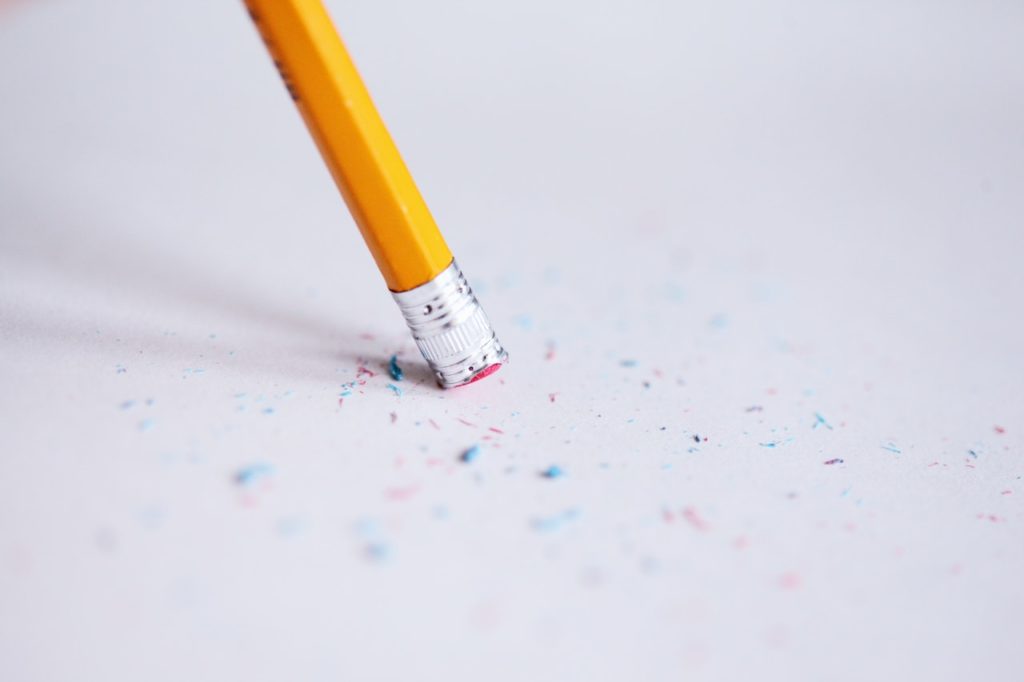
I learned this today. Erasers work because of friction. They become sticky when they are hot and hold onto the graphite particles.
Before we look at how erasers work, I think we need to look at how pencils are able to write on paper.
Pencils are made with graphite. These days the graphite is mixed with different amounts of clay to change the darkness of the pencil mark, but when they were first made, they were pure graphite.
Graphite is a crystalline form of carbon with its atoms arranged in a hexagonal structure. Apparently, graphite was named “graphite” because of its ability to leave marks on paper. It was named by the German mineralogist Abraham Gottlob Werner in 1789 and comes from the Ancient Greek graphein, which means to write or to draw.
Graphite is a natural mineral, and it was first discovered in England in the 1550s. The people realized that the new “rock” left marks on things, and they used it to mark sheep. The idea for making pencils from it came a little later.
When you draw a line on a piece of paper with a pencil, carbon molecules are breaking off and staying behind on the paper. Graphite is made of sheets of carbon layers. These layers stack on top of each other and are held together by a weak atomic bond. When a force is applied, a layer of carbon atoms can be sheared off. This is how graphene is made. It is also why the pencil draws on the paper. The force applied to the pencil graphite is friction. The cylinder of graphite slides across the paper, which is made of cellulose fibers, and the graphite atoms catch against the fibers and get sheared off. The carbon molecules stay stuck in the gaps between the fibers. If you looked at it under a microscope, you would see that the carbon atoms are in the gaps between the fibers and that the pencil line is not completely smooth, but, with our eyes, it looks like a smooth line. It is important to note that the graphite doesn’t stick to the paper. It is basically a carbon dust that gets caught in the gaps between the fibers. That is why, over time, pencil marks fade as the dust falls out of the paper.
The eraser erases the pencil mark by using friction as well. Modern erasers are made from polyvinyl chloride, which is a petroleum-based synthetic rubber. When you rub the eraser on the paper, friction causes it to heat up. As it gets warmer, it gets softer and stickier. Because it is soft, it is able to get in the gaps between the cellulose fibers and the carbon molecules stick to it. Bits of eraser come off in eraser bits because the friction against the paper pulls them off.
Rubber erasers were invented in 1770 by an English engineer called Edward Naime. Before that, people used rough stones to rub the marks off the paper, but that would damage the paper. Sometimes moist bread was used. But it would go moldy. That means people used pencils for almost 200 years before the eraser was invented. I love information like this. We wouldn’t think of pencils without erasers these days. They go together. And yet people didn’t know about erasers for 200 years. I wonder what things people will have 200 years from now that we haven’t thought about. Something that seems so obvious with the benefit of hindsight.
Naime claimed that he discovered the eraser properties of rubber when he picked up a piece by accident instead of some bread. He erased his pencil lines and realized that the rubber was better than the bread. In fact, rubber became called rubber because of its ability to rub pencil out, not the other way around. Before this event, rubber was called caoutchouc, which was its original Native American name.
Naime started to sell his erasers, but one of the problems with natural rubber is that it perishes. It gets hard and starts to crack and crumble. In 1839, Charles Goodyear discovered the process of vulcanization, which cured rubber and made it more durable. You may recognize his name from the tire company, which was named for him, but after he had died.
In 1858, American Hymen Lipman came up with the idea of attaching an eraser to the end of a pencil. He tried to patent it but was told that you can’t have a patent for attaching two existing devices together.
In 1909, a German team managed to make the world’s first synthetic rubber. Vinyl plastic erasers were invented in the mid-20th century. They are better than rubber erasers because the graphite doesn’t stick to them as much, so they don’t smudge. They are also softer and don’t damage the paper as much.
So, erasers work by using friction with the paper to heat up and become sticky. Then they stick to the carbon particles that have flaked off the pencil and stuck in the gaps between the fibers in the paper. And this is what I learned today.
Photo by Poppy Thomas Hill from Pexels
Sources:
https://en.wikipedia.org/wiki/Graphite
https://www.wonderopolis.org/wonder/how-does-an-eraser-work
https://science.howstuffworks.com/innovation/everyday-innovations/erasers-erase.htm
https://www.thoughtco.com/how-do-pencil-erasers-work-604298
https://www.seniorcare2share.com/why-does-graphite-leave-a-mark-on-paper/
https://www.physicsforums.com/threads/graphite-pencil-and-paper.45471/
https://en.wikipedia.org/wiki/Paper
https://en.wikipedia.org/wiki/Eraser
https://www.theatlantic.com/technology/archive/2014/10/why-do-erasers-suck-at-erasing/381025/
https://en.wikipedia.org/wiki/Natural_rubber

